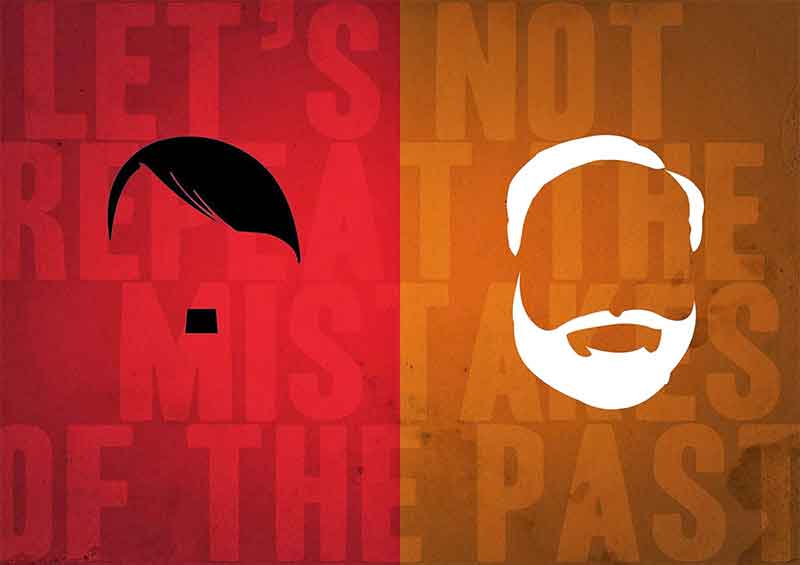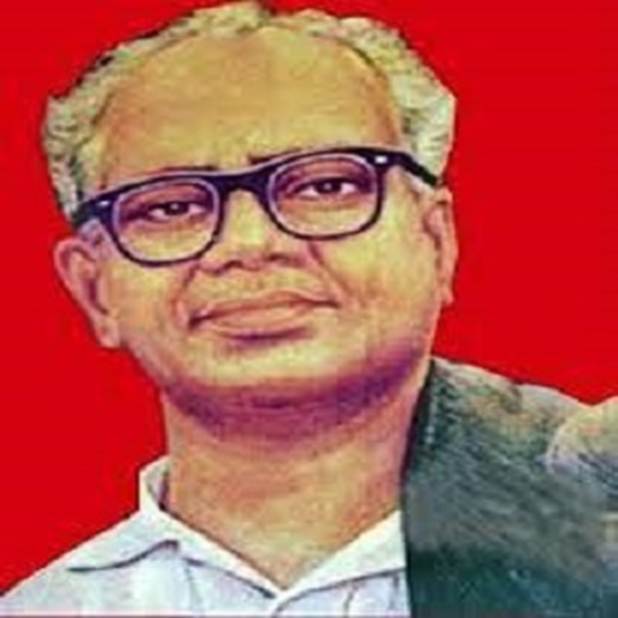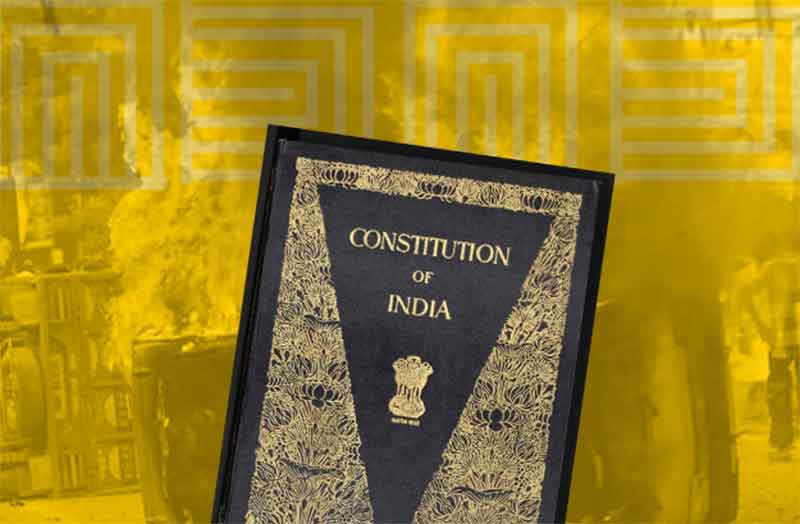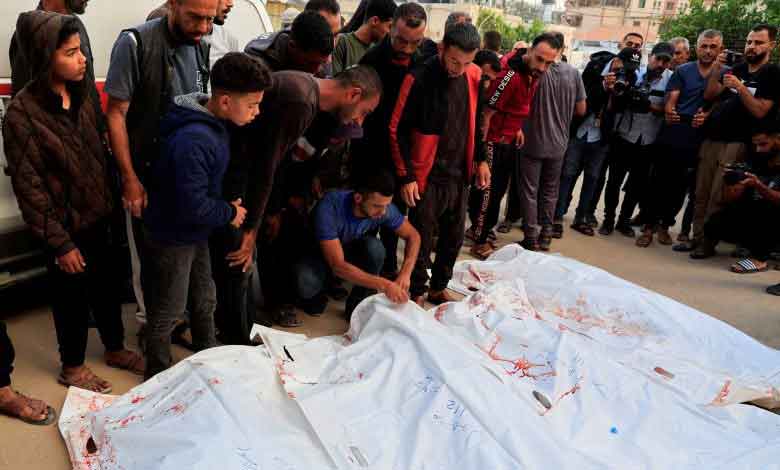This article analyses how the CPI (M)’s debates around fascism are becoming a chronic historical tragedy. The chronicity in history is how Hindutva politics, which took the shape of terror by capitalizing on the position of those calling for a ‘united front’ in alliance with the Jana Sangh against the Emergency, is once again becoming the beneficiary of the CPI (M)’s political stance.

During the early stage of the Emergency, the CPI (M) leadership prioritized planning its resistance to Indira Gandhi’s dictatorial rule. Historical records show that the issue of alliances and the extent of support to be extended gave rise to serious party deliberations, leading eventually to the resignation of P. Sundaraiah, the then-general Secretary. Portions of his later-published resignation letter show Sundaraiah believed the CPI (M) leadership was compromising the ideological purity of its positions.
In a different political situation half a century ago, political polemics and party politics that occurred within the Communist Party are of no scholarly interest today. If political opposition during the Emergency, even against the party general secretary, served to politicize the Sangh Parivar, then the CPM is reading the same history in another form by arguing that Modi’s government is not a neo-fascist government, but a government with neo-fascist inclinations. The gainer in both cases is the Sangh Parivar itself.

The draft resolution indicates that the party is coming to the conclusion that the RSS-dominated Modi government, which has been described as fascist by the CPM, has not led India to fascism. In the draft political resolution drawn up to be placed before the upcoming party congress in Madurai, the CPM states that the Modi government does not amount to fascism. Additionally, the CPM argues that unless the Modi government, which has neo-fascist tendencies, is confronted and defeated, it would inevitably slide into neo-fascism. By stating that this perception differs from the stands of other prominent communist groups, i.e., the CPI and the CPI-ML, the party seems to be paving the way for the possibility of a debate on the question among Left parties and the CPM.
The Political Opposition to Fascism and Sundaraiah’s Complaints
Let us return to the resignation letter of Sundaraya and the fundamental issue of strategies for coping with the dictatorship of Indira Gandhi. In his resignation letter, P. Sundaraya specifically stated that the Politburo did not intend to adhere to the method decided by the CPM in coping with the dictatorship of Indira Gandhi.
P. Sundaraya argued that the party then erred in believing that a collective struggle against the authoritarian regime of Indira Gandhi and the curtailment of civil liberties did not call for the constitution of a political alliance of all opposition parties. He claimed that the resolution adopted by the Central Committee then categorically stated that a collective action against civil rights groups, leaders of political parties, and civic personalities did not mean a collective political front of all opposition parties; however, this clarification was not included in subsequent proposals, thus creating the impression that a political alliance against Indira Gandhi was actually on the cards that involved all opposition forces. Sundaraya developed this argument. The charge assumed that steps were being taken in violation of the Central Committee decision of March 14, 1975, and that many members of the Politburo had authorized these steps.
“In our committee formation and operations for the defense of democratic rights and civil liberties, it is imperative for our cadres and members to remember at all times our leading principle of unity of leftist and democratic forces. This principle avoids participation in the chorus of so-called unity of all opposition parties against the Congress, and also the initiation of Jana Sangharsh Samithis under J.P.’s leadership, which talks of the Bihar model of organization”, he stated in his dissent note.
P Sundaraiah’s grievance was that the party’s failure to form a political front against Indira Gandhi and to have a clear-cut understanding that party members were only participants in the struggle for civil rights was not a political front, and that there was no political front with the right wing like the Jana Sangh and the Congress (O) was watered down. He provides an example of this in the shape of an incident.
Sundaraiah points out the fact that the activities of Jyotirmoy Basu, the party’s parliamentary whip, created the impression of an undivided opposition from the Jana Sangh to the CPM. He points out the fact that Basu spoke on the party position against the Janata leaders and, despite a direct request by the General Secretary, ignored it and continued to attend such meetings again. Sundaraiah further argues that no action against him has been taken because most members of the Politburo are not conscious of the peril involved. It can be observed from the memorandum of P. Sundaraiah that P. Ramamurthy, Jyotirmoy Basu, and B.T. Ranadive were of the view that they must join the J.P. movement.
History has shown that the ‘coordinated’ fight against the Emergency was a failure for the Indian Left movement and a huge triumph for the far right. Communist parties believe that a correct understanding of political processes is of vital importance in the strategy to be followed. P. Sundaraiah’s resignation shows that there were other currents of thought in the CPM leadership regarding the Emergency and the fight against it.
P Sundaraiah’s complaint was that subsequently the party made a mistake in strategy in that a shared opposition to Indira Gandhi’s authoritarianism and restriction of civil liberties did not necessarily translate into a political alliance of all opposition parties.
Neo-fascism and the Modi administration
There were previous reports that there were different views in the CPM on whether the RSS-led Modi government is fascist. Having used the term neo-fascism in the new draft, a note in the party journal Chinta Weekly stated: “The neo-fascist features are the attempt to enforce a reactionary Hindutva agenda and the extra powers to repress the opposition and democracy. This is the first time that we are employing the term ‘neo-fascist’ in the section on the national situation of the political resolution.”
Later, the opinion piece clarifies the language used in previous congresses: “During the 22nd Congress, we described that the attacks conducted by the very authoritarian Hindutva movement evidenced ’emerging fascist tendencies.’ At the 23rd Congress, we further stated that the Modi government was implementing the fascist agenda of the RSS.”
Briefly, the CPM has come to the conclusion that Modi’s government is not implementing fascist policy but merely displaying aspects typical of neo-fascism.
This article is another criticism of the Modi government and the Bharatiya Janata Party (BJP) by Prakash Karat. In an article dated July 28, 2016, published in the Deshabhimani newspaper, Prakash Karat explains: “The BJP is not a typical bourgeois party. It is a party that has a relation to the Rashtriya Swayamsevak Sangh (RSS). It is a right-wing party and an expression of majority communalism. Because of its relation with the RSS that has a semi-fascist ideology, the BJP will become an authoritarian party under favorable circumstances. So, it can be said that the BJP is a reactionary party. But it does not have the status of a fascist party.”
Karat clarifies that fascism is not only an ideology but a political force that also came into existence during the inter-war period of the 20th century. Karat quotes Dimitrov’s description of fascism and clarifies that such fascist regimes have not occurred in the world since then. In his extremely controversial article, Prakash Karat clarifies that the phenomenon of fascism appearing in India is unlikely in the current scenario.
Karat clarifies that fascism is both an ideology and political form of domination that arose in the interwar years of the 20th century. In support of this assertion, he quotes Dimitrov’s accounts of fascists, asserting that there have not been governments with fascist ideals in the world since then.
The reason for this conclusion may be due to the continued holding of elections and the existence of opposition political parties. It is also significant that the creation of concentration camps, similar to those in Germany, has not happened in India yet. This was followed by the Citizenship Amendment Act and reports of prisons for those who were declared to be ‘immigrants’. Maybe because CPM could not take mob lynchings, bulldozer raj, and communal attacks on Dalits and Muslims as indicators of fascism from communal analysis, it regarded Modi as a government with neo-fascist inclinations.
Sundaraiah referred to the risks involved in confronting the Jana Sangh and Jayaprakash Narayan, both of whom turned toward right-wing politics during the time of the Emergency, without truly identifying their positions. He postulated that political alliance with all opposition parties was not possible. There are no obvious similarities between Sundaraiah’s letter discussed at the outset and the CPM’s new political resolution. They can be regarded as reactions to two political developments in two situations. But not just that, there are some ominous similarities. Sundaraiah’s anxiety in her note was the risk of cooperating with the RSS and its political incarnation while vehemently opposing Indira Gandhi’s authoritarianism. Time has taught the nation what the outcome of that anxiety was. Hindutva communal forces took over the nation. The courts and constitutional bodies became the only enforcers of government policies. The Citizenship Amendment Act was enforced by keeping the Constitution before them. With the assistance of the system, Muslims were alienated and converted into internal enemies.
There are many things distinguishing Indira Gandhi’s dictatorship from the RSS’s fascism and that of Modi’s government. Most important among them is that these mobs brainwashed by racist hatred were not created at the time. In the post-Emergency phase, at least to some extent, restoration of constitutional institutions became possible. Everyone knows it to be clear as daylight that RSS-led government altered India in 10 years in a way, which could have never been realized through an election victory. However, the draft of CPM makes it apparent that these are just some among many indications of fascism in present times. Sundaraiah pointed out the danger of going against both the Jana Sangh and Jayaprakash Narayan, who were on the right-wing political fronts during the Emergency, without properly recognizing their stands. He claimed that the real situation was that political cooperation with all opposition groups was impossible.
Subscribe to Our Newsletter
Get the latest CounterCurrents updates delivered straight to your inbox.
History is repeating itself in another guise, either farcically or tragically. As the Modi government is not being evaluated as classical fascist or neo-fascist, now the CPM can claim that Dimitrov’s position of united front against fascism is no longer required here. The repetition of history is that Hindutva politics, in the form of terror by riding on the position of those who demanded a ‘united front’ against the Emergency, is again becoming the beneficiary of the political position of the CPM.
Mubashir VP is a freelance journalist based at New Delhi. He could be reached at [email protected]
















































